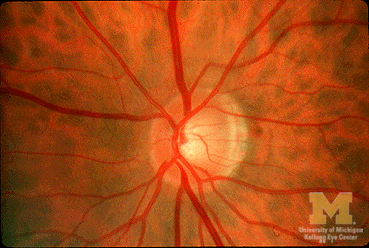-
Optic Neuritis
Optic neuritis is inflammation of the optic nerve that may cause cause loss of vision usually because of the swelling and destruction of the myelin sheath covering the optic nerve.

Up to 50% of patients with Multiple Sclerosis (MS) will develop an episode of optic neuritis, and 20-30% of the time optic neuritis is the presenting sign of MS. The presence of demyelinating white matter lesions on brain MRI at the time of presentation of optic neuritis is the strongest predictor for developing clinically definite MS.
Some other causes of optic neuritis include infection (e.g. syphilis, Lyme disease, herpes zoster), autoimmune disorders (e.g. lupus, neuro-sarcoidosis), inflammatory bowel disease, drug induced (e.g. chloramphenicol, ethambutol), vasculitis, B12 deficiency and diabetes.
On Ophthalmic examination the head of the optic nerve can easily be visualised by a slit lamp with high plus or by using a direct ophthalmoscopy but frequently there is no abnormal appearance. Often there is a desaturation of colour especially Red when comparing eyes.

Optic neuritis typically affects young adults ranging from 18–45 years of age, with a mean age of 30–35 years. There is a strong female predominance.
Treatment and prognosis
A Cochrane Systematic Review studied the effect of corticosteroids for treating participants suffering from optic neuritis. Treatments reviewed included intravenous methylprednisone, oral methylprednisone, and oral prednisone. All treatments reviewed did not show any benefit in terms of recovery to visual acuity, contrast sensitivity, or visual field.
In the longer term, there is evidence that patients with MS who first present with optic neuritis have a relatively more benign MS course.
http://en.wikipedia.orgMore Video’s on Optic Neuritis
Location & Contact Details
© 2017 - 2024 Noel Templeton Optometrists



